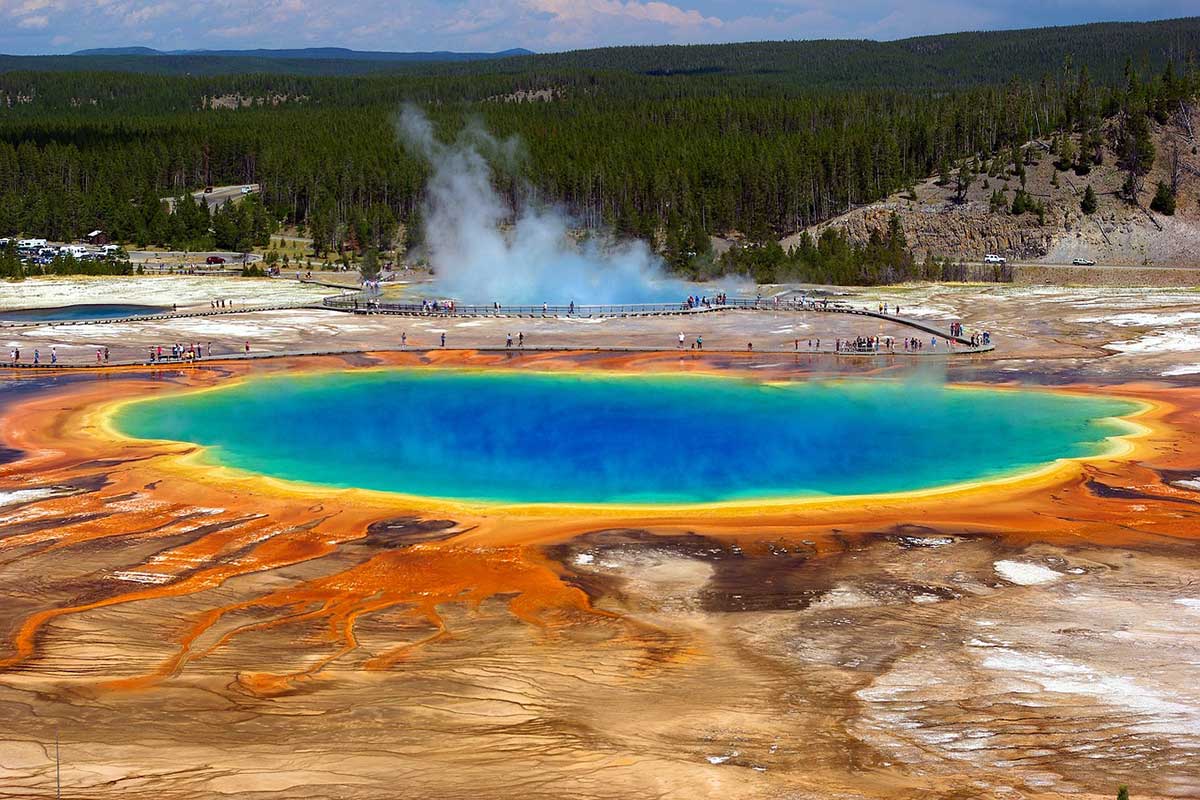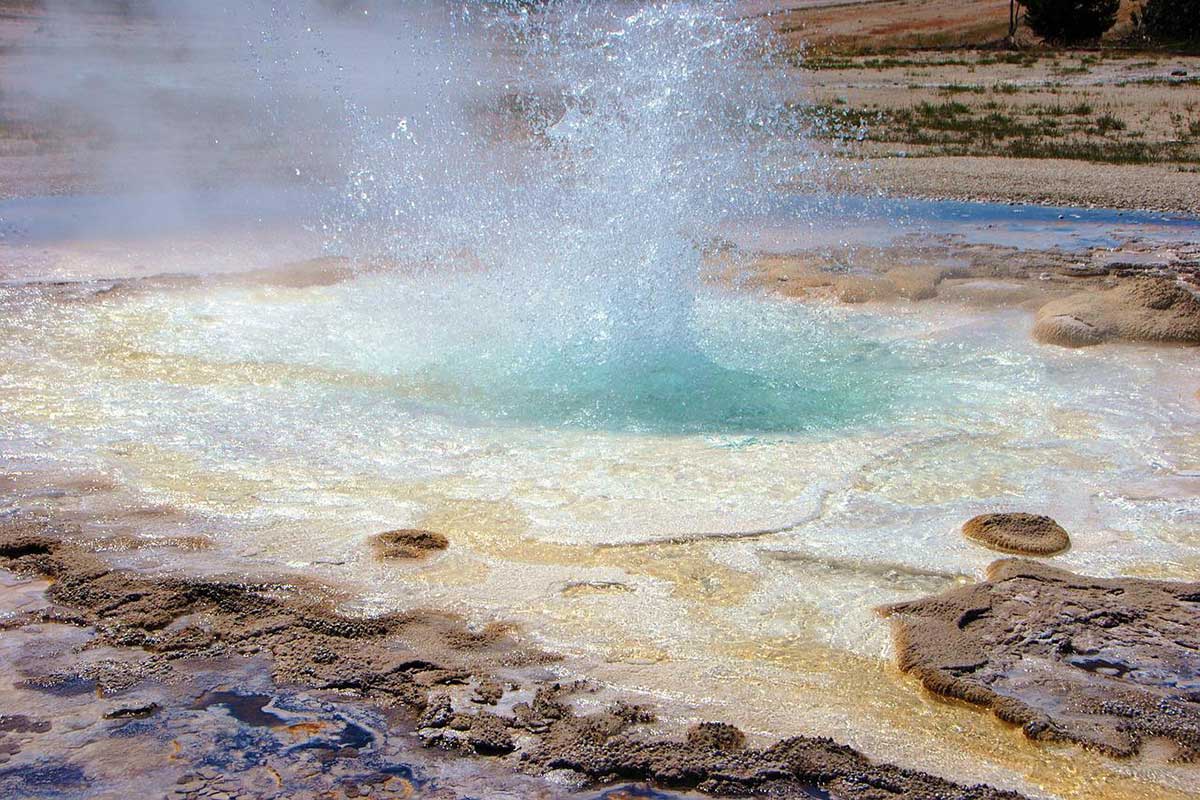Yellowstone is unique from other National Parks in many different ways from the diverse wildlife to the unique geothermal features found in the park. The latter is exactly what we’re discussing in this article, the geysers and hot springs in Yellowstone National Park.
Most of Yellowstone is actually contained within an ancient volcanic caldera. The last eruption of this volcano was approximately 600,000 years ago.
Over thousands of years, the lava-filled the caldera and cooled. But even though it is no longer erupting, there is lava close beneath the surface of the Yellowstone plateau. As close as 2-5 miles in some places. All this underground heat so close to the surface is what creates the various geothermal features found at the park today.
Geysers of Yellowstone
Geysers are hot springs that have underground channels where the water becomes trapped. The trapped water continues to heat and through building steam and pressure eventually erupt and will continue to erupt until the water in the channel is depleted and/or the steam runs out.
More geysers are found in Yellowstone than anywhere else on earth. There are roughly 500 geysers in the park. The geyser named Steamboat is the largest in the world. Its eruptions are few and far between, but when it does the water can reach a height of 300-400 feet!

Yellowstone contains both types of geysers, Cone geysers and Fountain geysers. The most famous geysers in Yellowstone due to their predictable eruptions or impressive heights are the Beehive geyser, the Castle geyser, the Clepsydra geyser, the Cliff geyser, the Echinus geyser, the Great Fountain geyser, the Lion geyser, Old Faithful, the Riverside geyser, the Steamboat geyser, and the White Dome geyser.
Yellowstone’s most famous geyser, Old Faithful, was discovered in 1870 by the Washburn Expedition. It got its name from being one of the more frequent and predictable geysers, erupting approximately every 70-90 minutes. Old Faithful has erupted over a million times since the park was opened in 1872. It can send water between 100-180 feet in the air.
It is estimated each eruption of Old Faithful can contain between 3,700 to 8,400 gallons of water, depending on how long the eruption lasts. The temperature of the water is around 200 degrees Fahrenheit (95.6 Celcius)
Old Faithful’s eruption times are predicted daily by park rangers. They record the start and end times of each eruption and use the duration to estimate when the next eruption will be. Generally, if the length of the eruption is less than 3 minutes the next eruption will be in 68 minutes. If the length of the eruption was more than three minutes long, the next eruption will be in about 94 minutes.
If you are visiting the park you can find out when Old Faithful is predicted to erupt in a few ways. Predictions are posted at the Old Faithful visitors center, on Twitter at @GeyserNPS, and online at the national park service website.
Not all geyser eruptions are predictable. Some geysers in the park erupt every few hours, while some erupt irregularly only a few times a year. For example, the Giantess geyser goes entire years without erupting and when it does can last between 4 to 48 hours!
Other Geysers at Yellowstone that have posted prediction times on the Yellowstone website daily are Castle, Grand, Daisy, Riverside, and the Great Fountain.
Hot Springs in Yellowstone National Park

Hot springs are the most common hydrothermal features in Yellowstone. Hot Springs are pools of water heated from below. The pool is large enough to allow the water to circulate, releasing steam at the top to cool surface water which then returns to the bottom of the pool.
Microorganisms especially suited for life in hot water (called thermophiles) thrive, and are often very colorful. Thermophiles can only live in very specific ranges of temperature. The hottest water is located at the center of the pool and then cools as the water becomes shallower. This means different thermophiles that give off different colors create a gradient effect from the center of the pool outwards.
Perhaps the most famous example of this at Yellowstone is the Grand Prismatic Spring. Grand Prismatic is one of the most photographed and recognized attractions at Yellowstone.
Another of the most famous of Yellowstone’s hot springs is the Mammoth Hot Springs complex. Over thousands of years, the hot springs constantly deposit calcium carbonate, building up terraces of Travertine (a type of limestone created by deposited mineral springs).
A unique activity to do at the park during certain times of year is to swim in the Boiling River. Located near the north entrance to Yellowstone in Gardiner, Montana this swimming area is open from autumn through the winter. In spring the waters rise and are too dangerous for swimming and remain that way through late summer. At the Boiling River, hot water from a natural spring enters the cool water of the Gardner River, creating a mix of comfortably warm water.
Many hot springs appear bright blue in color. The hot springs appear blue for the same reasons as a lake or an ocean, water strongly absorbs colors at the red end of the spectrum and reflects back mainly light in the blue wavelength. However, the brightness of the blue in the springs can be attributed to the depth of the water and its clarity.
Mudpots in Yellowstone
Mudpots are similar to a hot springs only in these areas sediment is saturated with water, forming a clay-like / mud-like substance. The heat below creates pockets of steam that bubble to the surface. This creates a rolling mud-boil effect and can sometimes expel mud into the air.
The main two areas to view mud pots at Yellowstone are the Artist Paint Pots (south of the Norris Geyser Basin) and the Fountain Paint Pots (in the Lower Geyser Basin).
Steam Vents in Yellowstone
Steam Vents, also called Fumaroles, are technically the same as hot springs only they contain such a small amount of water that the heat boils it away before it can reach the surface, so all you see is billowing steam.
Fumaroles can often cause a hissing or whistling sound, almost like a teapot, from the steam being quickly forced through the small channel.
